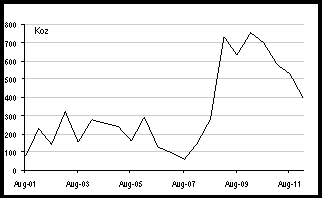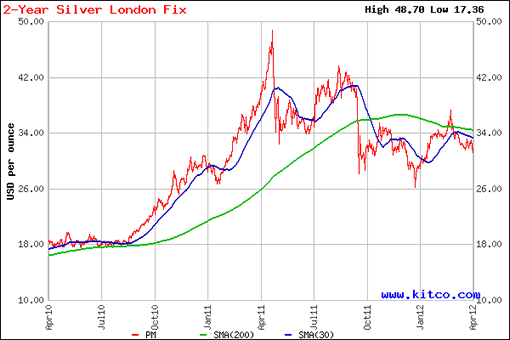 The midweek trading session in precious metals opened to the downside in New York this morning despite a 0.31% drop in the US dollar on the trade-weighted index and a 0.30% gain in crude oil values. Then again, yesterday, we witnessed the price of gold rising nearly $20 along with gains in the US dollar. Spot gold was down $4 at $1,656.50 while spot silver fell 23 cents to $31.61 the ounce.
The midweek trading session in precious metals opened to the downside in New York this morning despite a 0.31% drop in the US dollar on the trade-weighted index and a 0.30% gain in crude oil values. Then again, yesterday, we witnessed the price of gold rising nearly $20 along with gains in the US dollar. Spot gold was down $4 at $1,656.50 while spot silver fell 23 cents to $31.61 the ounce.
In this morning’s annual gold survey presentation, Thomson Reuters GFMS analysts noted that net gold investment demand fell last year. The finding dovetails with the revelations we recently saw in the CPM Group’s similar annual round-up of market facts and figures. CPM had reported a near 6% drop in investment offtake last year. There was good demand for gold bars but on the other hand the 2011 metrics in gold coin sales — at least as reported by the US Mint — are worth translating into a visual, as they show how the retail market chased rising gold prices and then soured significantly in the wake of that which was perceived as a possible top in the yellow metal:

Platinum dropped $7 to the $1,588.00 mark and palladium eased $4 to the $634.00 level. Good news for the PGM complex was noted this morning in the story that Chinese automobile sales rose 4.5% last month, beating analysts’ estimates. The gains were attributed to sales-sensitive dealers expanding discounts to buyers in the wake of record fuel prices. German auto sales also came in quite strong; VW and BMW posted fresh sales records in Q1.
No changes were noted in rhodium at $1,350.00 on the bid-side. Copper did lose another 0.35% however, even as all other base metals eked out small gains ranging from 0.10% to 0.30% this morning. Most of the appreciation in base metals was attributed to the just-received reports of a large quake near Sumatra. The quake, it was said, triggered some initial buying activity in nickel and tin especially, and saw some sympathy buying from the rest of the complex. There are nickel and tin operations in and around the region’s islands.
Nervousness continues to define the markets in the wake of tepid Chinese economic data and last Friday’s US jobs figures. US equity markets suffered another day of losses on Tuesday and the Dow now rests just above the 12,700 level. There is some concern that the string of losing sessions on Wall Street could engender margin calls that might affect precious metals positions among certain investors. For the moment, the Dow futures appeared to be receiving a lift from the reported profits at aluminum giant Alcoa.
The latest daily Standard Bank commodities report indicated that according to the latest CFTC data, open interest in COMEX gold fell by 11.8 tonnes. The newest tally shows the lowest such level since January 2009, and also marks the sixth successive week of decline.
SB’s analysts note that "over these six weeks, open interest has fallen by a total of 215.0 tonnes, which has been accompanied by an 8% fall in the gold price over the same period."
As for the all-important ETF space, the enthusiasm levels in that niche remains lackluster, as seen in a
"noncommittal 1.1 tonnes that were added to holdings of over the past week." SB’s report concludes that "as in the futures market, there appears to be a growing lack of confidence in gold’s prospects."
The good news if any in ETFs is that we have not seen any major liquidations just yet. However, it will be interesting to parse the various fund reports for their Q1 gold ETF buy/sell activity when they become available.
Albeit India’s jewelers have returned to work, and plan to stay on the job until May 11 while they hope for favorable pronouncements from the government, they are gearing up for an Akshaya Tritiya season that will likely see quite a bit of glitter having been taken off of gold. Some locals have turned wary about the gold taxation issue and have begun contemplating the purchase of gold coins or even the opening of bullion trading accounts in lieu of decorative gold items.
Meanwhile, according to trading giant Scotia Mocatta, India’s silver imports are potentially set to fall by up to 27% this year as extreme price volatility in the white metal is driving would-be buyers away. India consumes the largest amount of silver globally but its denizens loathe the price gyrations which have left many of their North American counterparts also licking their wounds since at least one year ago. As a result, Scotia Mocatta projects that only some 3,500 tonnes of silver might be imported into India as opposed to the nearly 5,000 tonnes that the country took in during 2011. Behold the roller-coaster ride in silver that has given its buyers a case of intense vertigo ever since the middle of 2010:

Almost all of the recent wariness over gold’s price gain prospects has to do with substantially lowered expectations of global liquidity growth among speculators, but in particular, the doubts that have emerged about a third round of Fed QE. In fact, in the opinion of veteran market watcher and economist Dennis Gartman, the "fatal blow to gold’s ten-year bull market" was in fact delivered last week by none other than a very mildly hawkish Ben Bernanke.
Mr. Gartman dissected gold’s trend-lines and came to the conclusion last Thursday that "in retrospect it does appear that gold has not been in a bull market but has indeed been in a bear market" since August 2011, when it peaked above $1,900. "Since then," he added "each new interim low has been lower and each new interim high has followed [lower as well].
China was in the global markets’ focus once again on Tuesday as its customs bureau reported an unexpected trade surplus of $5.35 billion. The issue with the trade picture was the fact that while exports did show an increase of 8.9%, imports climbed by only 5.3% pointing to tepid domestic demand. Analysts had expected a deficit of $3.15 billion and were thus somewhat alarmed by the actual numbers as they still indicate a deeper economic slowdown than many have projected for the country. Asian markets declined in concert on the Chinese trade data and their selling sprees spilled over into the US equity market where the Dow lost 213 points and showed lingering concern about Friday’s jobs numbers as well as China-related anxieties at work.
The trade news from China and the highest reading in stockpiles in 22 years sent crude oil lower for a second day in New York yesterday. Black gold traded down 1.65% to touch $100.89 per barrel; a two-month low. Bellwether copper fell 1.5% as specs wondered where the demand for the orange metal might come from at this point. Back in the days when China was racing ahead economically at break-neck speed, it was easy to sit back and expect that country to provide the boost that so many fund managers and analysts dreamed of when projecting sky-high prices for everything from iron to copper to gold and to oil.
Now that a different economic reality is apparently setting in, the job of parsing China’s impact on commodities and figuring out the demand for same, has just become a tad more… difficult, to say the least. Researchers opine that there is a shift already underway in China from "hard" commodities to "soft" ones. The fact that a lot of housing and major infrastructure has already been completed — and perhaps even overbuilt — points to the next wave of demand as possibly taking place in agricultural and other "non-metallic" commodities. Oil, of course, will continue to play a critical role in powering everything.
If the IMF’s projections turn out to be correct, perhaps copper, oil, and other commodity traders and speculators might have to look far and wide (and beyond China as well) for demand that would support higher — or even current — price levels. The IMF warned that the price of "stuff" is in fact more likely to decline this year and next, rather than continue the torrid pace at which it grew over the past decade. In an update to its recently-issued (January) World Economic Outlook, the agency cautioned commodity-exporting nations to brace themselves for just such a potential scenario and it continued to place emphasis on crude oil as an important determining factor for the future of commodity prices.
The IMF also pointed out that central bank-originated stimulus does have its limitations. Many monetary authorities have already brought interest rates close to nil, and at that level, not only does it become not possible to cut them further, but "high government debt may constrain the scope for deficit-financed transfers of debt." The international agency will hold its spring meeting just a few days before the Fed meets later this month.
In news from the Old World, it now appears that if conditions deteriorate sufficiently on the economic front over in Spain, that country’s banks will need more capital in order to remain afloat. A deep recession would probably result in the writing of some obituaries for certain Spanish banks. Last week’s bond auction in Spain did not exactly give comfort to the markets, but, now, the Central Bank’s Governor, Miguel Angel Fernandez Ordonez, has stated that while recent reforms go some way towards resolving the Spanish banking industry’s problems, it might be a good idea for them to raise more capital… just in case.
Such developments have prompted some currency experts to project that the euro’s recent advances and stability may be ephemeral, at best. During Q1, the common currency appreciated by nearly 3% in the wake of the EU agreement on a second Greek bailout, and after the ECB gave regional banks a hefty helping of dough. However, all of that is now history, and the risk of a larger than 5% drop in the euro is seen as quite real by several of the most accurate foreign currency forecasting experts.
Analysts at Well Fargo & Co. and at Westpac Banking Corp. are calling for a $1.24-$1.26 euro:dollar rate by, or prior to, the end of this year. This is notable because we have seen a tandem gold:euro trade (inverse to the US dollar) having been manifest quite a number of times in recent months. Meanwhile, you may consult the technical report on the greenback, as produced by analysts at DailyFX.com right here; it advises "buying the dips."
Jon Nadler
Senior Metals Analyst — Kitco Metals
Jon Nadler
Senior Metal Analyst
Kitco Metals Inc.
North America
Disclaimer: The views expressed in this article are those of the author and may not reflect those of Kitco Metals Inc. The author has made every effort to ensure accuracy of information provided; however, neither Kitco Metals Inc. nor the author can guarantee such accuracy. This article is strictly for informational purposes only. It is not a solicitation to make any exchange in precious metal products, commodities, securities or other financial instruments. Kitco Metals Inc. and the author of this article do not accept culpability for losses and/ or damages arising from the use of this publication.
www.kitco.com and www.kitco.cn
Blog: http://www.kitco.com/ind/index.html#nadler










